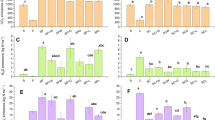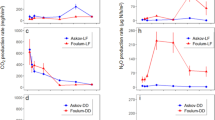Abstract
A 3-year study was conducted to determine the effects of anaerobic digestion (AD), large particle solids, and manure additive (More Than Manure, MTM™) on ammonia (NH3) and greenhouse gas (GHG; carbon dioxide, nitrous oxide, and methane) emissions when raw and treated manure were surface-applied. The presence of large particle solids resulted in greater NH3 emissions, probably, due to reduced infiltration of liquid manure into soil (P < 0.05). Anaerobic digestion did not have a consistent effect on NH3 emission. Manure with greater ammoniacal nitrogen (AN) concentrations had significantly greater NH3 loss after manure application (P < 0.05). Anaerobic digestion of manure also did not have a significant effect on GHG flux (P > 0.05). Raw manure with large particle solids had significantly greater CO2 flux than the other raw manure treatments on the day of manure application (P < 0.05). There was no significant manure treatment effects (P > 0.2) on methane flux over the 3-day period after manure application. The manure additive MTM™ did not have significant effects (P > 0.05) on NH3 and GHG fluxes. The results of this study suggest that solids and AN concentrations in manure are the most important factors affecting NH3 emissions after surface application.










Similar content being viewed by others
Abbreviations
- AD manure:
-
Anaerobic digestion (AD), anaerobically digested manure effluent
- Non-AD manure:
-
Raw dairy manure
- GHG:
-
Greenhouse gas
- ADWOS:
-
Anaerobically digested manure effluent with large particle solids removed
- ADWOSM:
-
Anaerobically digested manure effluent with large particle solids removed and MTM™ added
- ADWS:
-
Anaerobically digested manure effluent with large particle solids
- NADWOS:
-
Raw manure with large particle solids removed
- NADWOSM:
-
Raw manure with large particle solids removed and MTM™ added
- NADWS:
-
Raw manure with large particle solids
References
Abalos, D., Sanz-Cobena, A., Misselbrook, T., & Vallejo, A. (2012). Effectiveness of urease inhibition on the abatement of ammonia, nitrous oxide and nitric oxide emissions in a non-irrigated Mediterranean barley field. Chemosphere, 89(3), 310–318.
Amon, B., Kryvoruchko, V., Amon, T., & Zechmeister-Boltenstern, S. (2006). Methane, nitrous oxide and ammonia emissions during storage and after application of dairy cattle slurry and influence of slurry treatment. Agriculture, Ecosystems & Environment, 112(2–3), 153–162.
Arogo, J., Westerman, P., Heber, A. J., Robarge, W. P., & Classen, J. J. (2006). Ammonia emissions from animal feeding operations. In: Animal Agriculture and the Environment: National Center for Manure and Animal Waste Management White Papers (pp. 41–88). St. Joseph: ASABE.
Bhandral, R., Bittman, S., Kowalenko, G., Buckley, K., Chantigny, M. H., Hunt, D. E., et al. (2009). Enhancing soil infiltration reduces gaseous emissions and improves N uptake from applied dairy slurry. Journal of Environment Quality, 38(4), 1372–1382.
Bittman, S., Hunt, D. E., Kowalenko, C. G., Chantigny, M., Buckley, K., & Bounaix, F. (2011). Removing solids improves response of grass to surface-banded dairy manure slurry: a multiyear study. Journal of Environment Quality, 40(2), 393–401.
Chadwick, D., Sommer, S., Thorman, R., Fangueiro, D., Cardenas, L., Amon, B., et al. (2011). Manure management: implications for greenhouse gas emissions. Animal Feed Science and Technology, 166, 514–531.
Chantigny, M. H., MacDonald, J. D., Beaupré, C., Rochette, P., Angers, D. A., Massé, D., et al. (2009). Ammonia volatilization following surface application of raw and treated liquid swine manure. Nutrient Cycling in Agroecosystems, 85(3), 275–286.
Collins, H. P., Streubel, J. D., Frear, C., Chen, S., Granatstein, D., Kruger, C., Alva, A. K., et al. (2010). Application of AD dairy manure effluent to fields and associated impacts. CSANR Research Report: Climate Friendly Farming. http://csanr.wsu.edu/publications/researchreports/CFF%20Report/CSANR2010-001.Ch10.pdf . Accessed 10.15.2012.
Connell, J. A., Hancock, D. W., Durham, R. G., Cabrera, M. L., & Harris, G. H. (2011). Comparison of enhanced-efficiency nitrogen fertilizers for reducing ammonia loss and improving bermudagrass forage production. Crop Science, 51, 2237–2248.
de Klein, C. A. M., Sherlock, R. R., Cameron, K. C., & van der Weerden, T. J. (2001). Nitrous oxide emissions from agricultural soils in New Zealand—a review of current knowledge and directions for future research. Journal of the Royal Society of New Zealand, 31(3), 543–574.
De Vries, J. W., Groenestein, C. M., & De Boer, I. J. M. (2012). Environmental consequences of processing manure to produce mineral fertilizer and bio-energy. Journal of Environmental Management, 102, 173–183.
Dittert, K., Lampe, C., Gasche, R., Butterbach-Bahl, K., Wachendorf, M., Papen, H., et al. (2005). Short-term effects of single or combined application of mineral N fertilizer and cattle slurry on the fluxes of radiatively active trace gases from grassland soil. Soil Biology and Biochemistry, 37(9), 1665–1674.
Eaton, A.D., Clesceri, L.S., & Greenberg, A.E. (1995). Standard methods for the examination of water and wastewater, 19th Edition.
Gavlak, R., Horneck, D., Miller, R.O., & Kotuby-Amacher, J. (2003). Soil, plant, and water reference methods for the western region, 2nd Edition.
Hristov, A. N., Hanigan, M., Cole, A., McAllister, T. A., Ndegwa, P. M., & Rotz, A. (2011). Review: Ammonia emissions from dairy farms and beef feedlots. Canadian Journal of Animal Science, 91(1), 1–35.
Joo, H. S., Ndegwa, P. M., Harrison, J. H., Whitefield, E., Heber, A. J., & Ni, J. Q. (2012). Emissions of ammonia and greenhouse gases (GHG) from anaerobic digested and undigested dairy manure. Dallas: ASABE Meeting Presentation.
Kirchmann, H., & Lundvall, A. (1998). Treatment of solid animal manures: identification of low NH3 emission practices. Nutrient Cycling in Agroecosystems, 51, 65–71.
Kirchmann, H., & Witter, E. (1989). Ammonia volatilization during aerobic and anaerobic manure decomposition. Plant and Soil, 115(1), 35–41.
Li, L. F., Ogejo, J. A., Marr, L. C., Knowlton, K. F., Hanigan, M. D., & Gay, S. (2008). Ammonia emissions from dairy manure storage tanks. Rhode Island: ASABE paper.
Lovanh, N., Warren, J., & Sistani, K. (2010). Determination of ammonia and greenhouse gas emissions from land application of swine slurry: a comparison of three application methods. Bioresource Technology, 101(6), 1662–1667.
McCrory, D. F., & Hobbs, P. J. (2001). Additives to reduce ammonia and odor emissions from livestock wastes. Journal of Environmental Quality, 30(2), 345–355.
Michel, J., Weiske, A., & Moller, K. (2010). The effect of biogas digestion on the environmental impact and energy balances in organic cropping systems using the life-cycle assessment methodology. Renewable Agriculture and Food Systems, 25, 204–218.
Möller, K., & Stinner, W. (2009). Effects of different manuring systems with and without biogas digestion on soil mineral nitrogen content and on gaseous nitrogen losses (ammonia, nitrous oxides). European Journal of Agronomy, 30(1), 1–16.
Ndegwa, P. M., Hristov, A. N., Arogo, J., & Sheffield, R. E. (2008). A review of ammonia emission mitigation techniques for concentrated animal feeding operations. Biosystems Engineering, 100(4), 453–469.
Oenema, O., Wrage, N., Velthof, G. L., Groenigen, J. W., Dolfing, J., & Kuikman, P. J. (2005). Trends in global nitrous oxide emissions from animal production systems. Nutrient Cycling in Agroecosystems, 72(1), 51–65.
Paul, J. W., Beauchamp, E. G., & Zhang, X. (1993). Nitrous and nitric oxide emissions during nitrification and denitrification from manure-amended soil in the laboratory. Canadian Journal of Soil Science, 73(4), 539–553.
Pereira, J., Fangueiro, D., Misselbrook, T. H., Chadwick, D. R., Coutinho, J., & Trindade, H. (2011). Ammonia and greenhouse gas emissions from slatted and solid floors in dairy cattle houses: a scale model study. Biosystems Engineering, 109(2), 148–157.
Petersen, S. O., & Sommer, S. G. (2011). Ammonia and nitrous oxide interactions: roles of manure organic matter management. Animal Feed Science and Technology, 166, 503–513.
Pfluke, P. D., Jokela, W. E., & Bosworth, S. C. (2011). Ammonia volatilization from surface-banded and broadcast application of liquid dairy manure on grass forage. Journal of Environment Quality, 40(2), 374–382.
Pumpanen, J., Kolari, P., Ilvesniemi, H., Minkkinen, K., Vesala, T., Niinisto, S., et al. (2004). Comparison of different chamber techniques for measuring soil CO2 efflux. Agricultural and Forest Meteorology, 123, 159–176.
Rubæk, G. H., Henriksen, K., Petersen, J., Rasmussen, B., & Sommer, S. G. (1996). Effects of application technique and anaerobic digestion on gaseous nitrogen loss from animal slurry applied to ryegrass (Lolium perenne). The Journal of Agricultural Science, 126(04), 481–492.
SAS Institute. (2012). SAS system software: Release 9.2 (TS2M0). Cary: SAS Institute Inc.
Saunders, O.E., Fortuna, A., Harrison, J.H., Whitefield, E., Cogger, C.G., Kennedy, A.C., & Bary, A. (2012a). Comparison of raw dairy manure slurry and anaerobically digested slurry as n sources for grass forage production. International Journal of Agronomy, 1–10.
Saunders, O. E., Fortuna, A., Harrison, J. H., Cogger, C. G., Whitefield, E., & Green, T. (2012b). Gaseous nitrogen and bacterial responses to raw and digested dairy manure applications in incubated soil. Environmental Science & Technology, 46(21), 11684–11692.
Sherlock, R. R., & Goh, K. M. (1984). Dynamics of ammonia volatilization from simulated urine patches and aqueous urea applied to pasture field experiments. Nutrient Cycling in Agroecosystems, 5(2), 181–195.
Sommer, S. G., & Hutchings, N. J. (2001). Ammonia emission from field applied manure and its reduction—invited paper. European Journal of Agronomy, 15, 1–15.
Sommer, S. G., & Olesen, J. E. (1991). Effects of dry matter content and temperature on NH3 emission. Journal of Environmental Quality, 20, 679–683.
Thompson, R. B., & Meisinger, J. J. (2004). Gaseous nitrogen losses and ammonia volatilization measurement following land application of cattle slurry in the mid-Atlantic region of the USA. Plant and Soil, 266(1), 231–246.
Thompson, R. B., Pain, B. F., & Rees, Y. J. (1990). Ammonia volatilization from cattle slurry following surface application to grassland. Plant and Soil, 125(1), 119–128.
USEPA. (2012). U.S. Greenhouse Gas Inventory Report. Chapter 6.
van der Meer, H. G. (2008). Optimising manure management for GHG outcomes. Australian Journal of Experimental Agriculture, 48(2), 38–45.
Varel, V. H. (1997). Use of urease inhibitors to control nitrogen loss from livestock waste. Bioresource Technology, 62(1), 11–17.
WSDA. (2011). Washington Dairies And Digesters. Washington State Department of Agriculture. http://agr.wa.gov/FP/Pubs/docs/343-WashingtonDairiesAndDigesters-web.pdf Accessed 10.15.2011.
Acknowledgments
This research was financially supported by USDA-NRCS CIG project no. 2008-0116-039—Nutrient Capture in an Anaerobic Digester and Specialty Fertilizer Products, Leawood, KS.
Author information
Authors and Affiliations
Corresponding author
Rights and permissions
About this article
Cite this article
Sun, F., Harrison, J.H., Ndegwa, P.M. et al. Effect of Manure Treatment on Ammonia and Greenhouse Gases Emissions Following Surface Application. Water Air Soil Pollut 225, 1923 (2014). https://doi.org/10.1007/s11270-014-1923-z
Received:
Accepted:
Published:
DOI: https://doi.org/10.1007/s11270-014-1923-z




